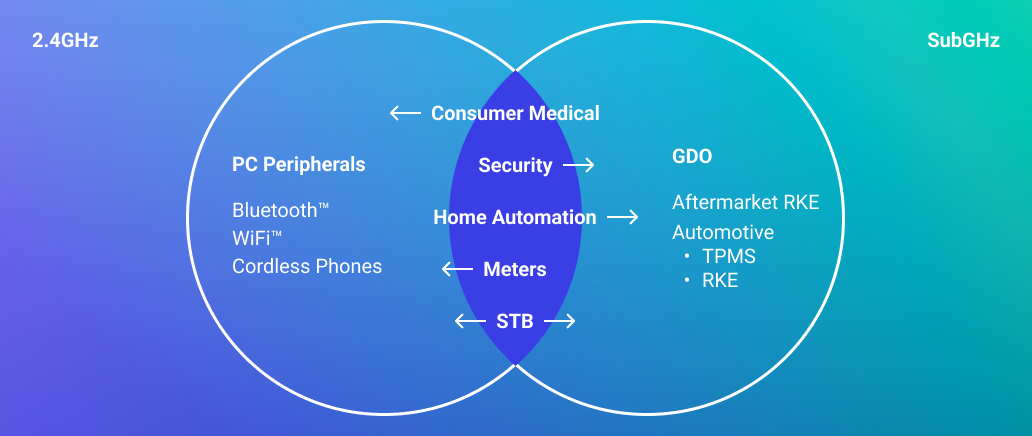Comparison of Sub-GHz Wireless Protocols


Wireless communication has grown rapidly over the last 20 years and is now widely used in many areas. The emergence of IoT has led to the development of Sub-GHz, a wireless communication standard. The purpose of this Sub-GHz wireless protocols comparison article is to give insight into some of them. Additionally, we would like to highlight our hardware engineering and design services, which have garnered significant popularity among our clients.
Key Takeaways About Sub-GHz Frequencies
Sub-GHz protocols have several advantages over other protocols on the market, such as:
- Operates over a longer distance (up to tens of kilometers, as opposed to Wi-Fi and Bluetooth which are limited to 300-500m).
- More power efficient.
- Data rates are far lower than 2.4 GHz.

Examples and Comparisons of Protocols That Use Sub-GHz Frequencies
SigFox
This is a cellular-style system. It uses ultra-narrow band technology (200 Hz), so the transmitter requires very little power to maintain a robust connection over long distances (30-50 km) while the data rate is a maximum of 140 messages per day per device, with up to 12 bytes payload (~100 bps).
LoRa (Long Range)
This is a type of modulation that enables long range communication (10s of kilometers) with low power consumption. It uses a wide bandwidth (7.8 kHz-500 kHz) and provides up to 37.5 kbps data rate.
IEEE 802.11ah (Wi-Fi HaLow)
This is a member of the standard Wi-Fi family. It is based on IEEE 802.11ac, but uses a sub-GHz band and a narrower bandwidth (1/2/4/8/16MHz).
Z-Wave
This is another communication protocol used mainly for home automation. It uses a mesh network architecture with up to 232 nodes in a network. The data rate is about 100 kbps and the range is about 30m.
802.15.4 PHY/MAC
This is the foundation for many protocol stacks (ZigBee, WirelessHART). Either band could be employed (data rates for sub-GHz 20-40 kbps vs 250 kbps with 2.4 GHz), the communication range is about 10 meters.
Zigbee
This is a low-power wireless communication protocol that can work in both 2.4 GHz and sub-GHz frequencies and is utilized for IoT applications. It has a 300-1000m open range and a decent data rate.
Wireless M-Bus
This protocol has low consumption and operates in the sub-GHz frequency range, commonly in the 868 MHz band in Europe, and the 915 MHz band in North America. Sub-GHz frequencies are less congested than 2.4 GHz frequencies.
Thread
The Thread protocol should be mentioned in our article about how sub-GHz wireless protocols differ. The protocol employs a mesh networking topology, allowing devices to be connected with one another and therefore extend the network’s range.
Comparison Table
Here you may examine the differences between sub-GHz wireless protocols:
| Protocol Name | Bandwidth | Range | Transfer Rate | Application Area | Advantages | Disadvantages |
| Sigfox | 100 Hz | Up to 40 km | 100 bps | IoT, smart cities, asset tracking | Low power, long range, low cost | Low data rate, limited bandwidth, low capacity |
| LoRa | Up to 500 kHz | Up to 10 km | Up to 50 Kbps | IoT, smart cities, agriculture, logistics | Long range, low power, low cost, scalable | Limited bandwidth, interference with other radio signals |
| IEEE 802.11ah (Wi-Fi HaLow) | 1-16 MHz | Up to 1 km | Up to 347 Mbps | IoT, smart homes, healthcare, agriculture | High data rate, long range, low power | Limited range compared to other protocols, interference with other Wi-Fi signals |
| Z-Wave | 900 MHz | Up to 100 m | Up to 100 Kbps | Home automation, smart homes | Low power, low interference, secure | Limited range, limited interoperability with other protocols |
| 802.15.4 PHY/MAC | 2.4 GHz, 868/915 MHz | Up to 100 m | Up to 250 Kbps | IoT, industrial automation, smart homes | Low power, low cost, flexible | Limited range, limited bandwidth, interference with other radio signals |
| Zigbee | 2.4 GHz | Up to 100 m | Up to 250 Kbps | Smart homes, home automation, lighting | Low power, low cost, secure | Limited range, limited interoperability with other protocols |
| Wireless M-Bus | 868/ 433 MHz | Up to 1 km | Up to 32 Kbps | Metering, smart cities, remote monitoring | Long range, low power, secure | Limited bandwidth, limited range compared to other protocols |
| Thread | 2.4 GHz | Up to 100 m | Up to 250 Kbps | Smart homes, home automation, lighting | Secure, low power, scalable | Limited range, limited interoperability with other protocols |
How Sirin Software Can Help
If you have been seeking a way to compare protocols that use sub-GHz frequencies, this article will surely have come in handy. Sirin Software additionally recommends that you only rely on professionals who can give you professional advice on your project. We can guarantee that with Sirin Software’s services, you should be sure that your device is developed to the highest standard, with keen attention to detail and a focus on efficiency and functionality. This results in devices that are not only reliable and user-friendly, but also innovative and cutting-edge, providing a competitive edge in the market.
Conclusion
We compared sub-GHz wireless protocols in this article. As was shown above, when developing an IoT solution that requires either long distance operation and/or autonomous power supply, one should also consider sub-GHz protocols as they are designed for long distance, low power, and low data rates communication. Be sure to visit our wireless solutions development page for a more in-depth exploration of this subject.
FAQ
What sub-GHz technology operates?
Sub-GHz technology operates on frequencies below 1 GHz. It is commonly used for long-range wireless communications, IoT devices, and smart metering systems.
Could you name some sub-GHz protocols?
In the article, we compared such protocols: SigFox, LoRa, IEEE 802.11ah (Wi-Fi HaLow), Z-Wave, 802.15.4 PHY/MAC, Zigbee, Wireless M-Bus, Thread.
How do Sub-GHz wireless protocols differ?
Sub-GHz wireless protocols differ in terms of range, data rate, power consumption, and frequency band allocation.